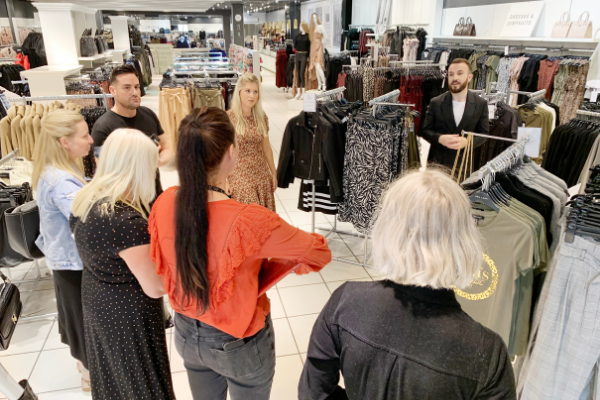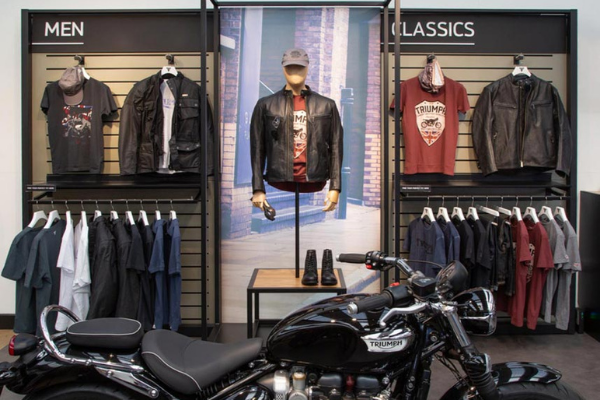Retail past, present and future: Karl McKeever on what’s next for visual merchandising and the retail sector
07 Jan 2021)
As we head into a new year, and with it, a new UK lockdown, the future for retail is looking murky. Whilst we’ve seen some good growth in sales and footfall since the summer, there’s no doubt that retail is going to have to adapt and change to fit in with new consumer habits forged in 2020. Ahead of his session at Spring Fair @ Home, we had a chat with visual merchandising expert, Karl McKeever to hear some of his top tips and find out where he thinks the industry is heading next.
How has Covid-19 changed the face of UK retail?
As we emerge from Covid-19, one thing is clear: the way we shop has changed. It was only natural that the lockdown would influence customer behaviour over the course of the year and, as Karl says, it has clearly “accelerated the use and acceptance of online shopping by many more people”. The real test for retail will come when we start to creep back to the old “normal”. With vaccinations on the horizon, will people return to the high street, or are people wedded to ecommerce?
Perhaps the biggest change, and winner, is the recognition that shops closer to home, and our smaller town centres still can play a vital role in the future.
For Karl, once people regain their confidence, it is only a matter of time before bricks and mortar shops to rebuild and recover, especially for local shops and high streets who will “play a vital role in the future of retail”.
It is this growth in consumer confidence – to travel, to go out to eat, to engage with their communities – that will ultimately trigger the resumption of some of the pre-pandemic trends and behaviours we were seeing before the pandemic, albeit at a faster pace. As Karl says, “the pandemic won’t have changed many of the fundamental issues and future solutions that were in development in the ‘tussle’ between physical and online shopping, but it has brought these forwards with an increased urgency”.
Karl advises that now is the time retail location strategies should (and will) be reviewed. As city centres shut down, in the short-term future, in favour of shopping destinations closer to home, local stores that were at risk of closure have the opportunity for a new and extended lease of life.
The online/ offline balance
The pandemic hasn’t sparked anything new with regards to online adoption though, it’s only sped up the growth in online retail that was already happening and the retailers that have recognised that are the ones coming out on top now; “when consumers couldn’t shop instore, they brands which had already invested in an effective ecommerce operation have been the real winners”.
Clearly the pandemic has accelerated the use and acceptance of online shopping by many more people
As a fundamental shift within the industry, “pressure on ‘physical’ retail has been increasing for some time” already, and it seems that “blended retail” will be the way forward. This will see retailers adopting ecommerce alongside their physical shop space to get the best of both worlds – online and instore – whilst reducing friction for customers who may want to interact on both touchpoints.
For Karl, the blended retail looks something like this: “in simple terms, it means shops will need to provide great instore experiences, with more emphasis on providing expertise, service, ease and convenience (the latter two provided, of course, by outstanding visual merchandising practices)”. In this way, “shops will do things the internet can’t do”, providing showrooming, one-to-one service, fitting and measuring, brand launches and events.

Ecommerce, meanwhile, will offer the ease and speed that customers are used to, with simple returns and collections and simpler browsing and filtering options. The online platform is where customers will ultimately buy; “shoppers may not buy instore by are ‘warmed up’ to purchase online in a two-way ebb and flow”.
Where does success lie in the future of retail?
For Karl, the most important thing to remember is to “not get distracted or bamboozled by technology”. Whilst ecommerce and the ever evolving world of technology can be overwhelming, it’s important to remember that “the fundamentals of the shopping process have in many ways remained the same as they always have been”: customers still have needs and want to know how and where these can be fulfilled; they still have their preferences when it comes to brands and retailers and will be loyal to those they value and feel valued by; they will return to those places that are able to satisfy their wants and needs; they want to share positive experiences with others; they want to identify with a brand, service, retailer and/ or experience.
The key is remembering that retail is fundamentally a human-centric trade and that people should remain at the beating heart of the in-store experience.
Past, present or future, “retail is fundamentally a human-centric trade and people should remain at the beating heart of the in-store experience”. However far technology or ecommerce takes us, people are at the core of the retail industry and it is those brands and outlets who make genuine connections who will succeed.
But genuine connections and meeting and exceeding your customers wants and needs can happen at any touchpoint. Karl says, “I believe that whether in a shop, on a catalogue page or device screen, you’re trying to satisfy the needs and wants of the shopper. That’s where great product presentation and information work together as a silent service”. For Karl, this means keeping it simple, to reduce customer friction, align messaging and keep teams on the same page, whether they’re located in or out of store.
The place of visual merchandising in future retail
Of course, as retail has evolved, visual merchandising has followed its progress, with an emphasis on enabling efficiency whilst trying to retain flair, personality and the “human touch”.
In the technology sphere, solutions like self-checkouts and app-based payments have created highly efficient solutions for those customers who want it, and these technologies offer greater choice and convenience. Moving into the future, “digital signage, digital pricing, online POS will soon become the next big thing for every mass market, high inventory retailer. So too, will the integration of online services that will seep into all aspects of customer experience and service delivery from digital mirrors, to virtual fitting rooms, to displays that speak and try to influence the sale”.

Of course, these are useful and interesting additions, but, for Karl, “there will never be anything more powerful than an attractively merchandised shop and well-presented fixtures, displaying products in a logical and helpful system, imaginative and creative features and window displays and personable service from real people who care about the customer’s time”.
Karl’s top tips for show stopping visual merchandising
So how can you improve your store, embrace a blended approach to retail and retain that all important customer service? For Karl, it starts with developing “your own distinctive visual merchandising style that represents your brand, product offer and service proposition”. As consumers dip their toes back into retail waters, don’t forget the importance of great retail standards: hygiene, housekeeping, availability and replenishment.
Karl recommends an easy 5-step approach:
- Use one clear, main theme per fixture, display or focal point. Don’t clutter or confuse multiple ideas.
- Use one dominant product as a centre piece to attract high attention and maximum ‘pulling power’.
- Integrate complementary products and details alongside to create a cohesive theme or promotional story.
- Keep it simple
- Execute and maintain high presentation standards in-store – whatever fixture or display type it is!
For even more insights from Karl, make sure you tune in to his webinar on Tuesday 9th February at Spring Fair @ Home.
If you enjoyed this article you might also like:





)
)
)
)
)
.jpg.png/fit-in/500x500/filters:no_upscale())
)
)
)
)
)
)
)
)
)
)
)
)
)
)
)
)
)
)
)
)
)
)
)
)
)
)
)
)
)
)
)
)
)
)
)
)